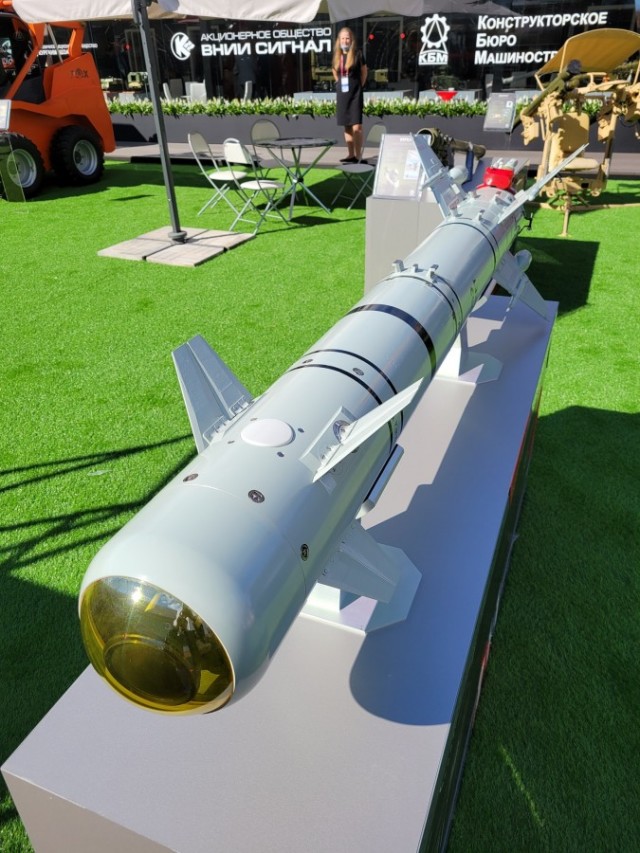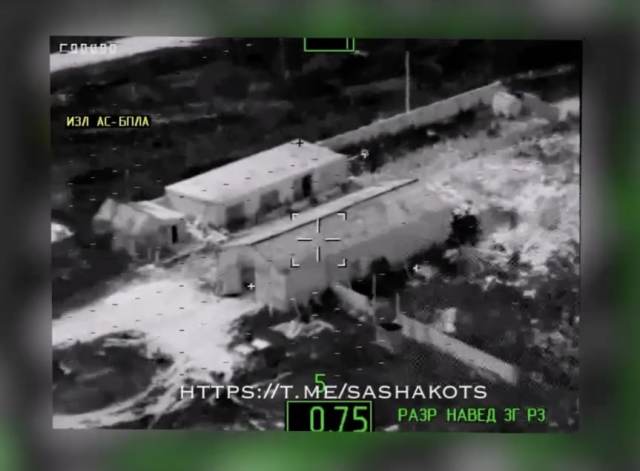Its warhead is more powerful than the shells of the heaviest self—propelled guns, and the new product can work both in the "shot - forgot" mode and in the search and selection mode of previously unknown targets.
According to an anonymous source of RIA Novosti in the military environment, the Russian army aviation began to use the Product-305 missiles, also known as LMUR (light multipurpose guided missiles), in a special operation. Contrary to the name, this is not just a guided missile, but a rather specific munition capable of acting both in the "shot—and-forget" autonomous mode, and right in flight to be retargeted by a human operator (who is in the helicopter that launched it) to another, more promising target.
The TNT equivalent of its warhead is 35 kilograms, which is about twice as much as the TNT equivalent of the 203-millimeter projectile of the self-propelled gun "Peony" and four to five times more than the TNT equivalent of the 152-millimeter projectile. That is, in terms of power, the new missile also falls into a specific class: it is much weaker than "Calibers" (warhead — 400 kilograms) and "Uranium" (warhead — 145 kilograms), but at the same time much more powerful than standard guided projectiles used by artillery.

The rocket was first shown to the public in 2021
Image source: Wikimedia Commons
Initially, the missile was created by order of the FSB to equip a certain Mi-8MNP-2 — a modification of the Mi-8, about which little is known from open sources. Its mass production began in 2016, but it did not enter the army for some time (although it is claimed that it was used in Syria).
The mass of the missile is 105 kilograms, the flight altitude is 100-600 meters (however, due to its small size and weight, it is relatively moderately vulnerable to air defense). The speed is up to 250 meters per second, the range is at least 14.5 kilometers (when launched from a helicopter in a hovering position at low altitude). In the case of launching from an aircraft at a speed or higher altitude, the range of the LMUR can significantly increase (up to 25 kilometers).
Earlier, Valery Kashin, the general designer of the Kolomna Engineering Design Bureau, noted that among the typical targets are not only tanks and not so much tanks, but all seriously protected targets in the front line. Moreover, it is claimed that it will be able to hit aerial targets (probably we are talking about helicopters).
According to a source of RIA Novosti, in Ukraine, LMUR is used "from aboard Mi-28NM attack helicopters on important objects of the Ukrainian troops, for example, ammunition depots and fuel." At the same time, the new missiles provide high accuracy of hitting targets — with a deviation from the line of sight of no more than two meters.
LMUR, used, presumably, from the Mi-28N helicopter. The operator is able to accompany the operation of the rocket without binding the helicopter pilot: after the launch, he can turn around and go deep into his territory without fear of losing control of the ammunition / © Youtube
Taking into account the power of the warhead of the "Product-305", we are talking about a fairly reliable defeat (with such a small error, almost any non-buried warehouse is affected). The Mi-28NM can take on board four such missiles at once.
As the experience of a special military operation has shown — for the first time in a long time implemented in the presence of a large number of enemy air defense systems — one of the key problems of aviation on the modern battlefield has become almost complete inability to work "visually". It is necessary to strike with bombs, unguided aircraft missiles (NAR) and similar weapons from a considerable distance, which does not allow the enemy to hit an airplane or helicopter with anti-aircraft missiles.
However, such strikes have a reduced accuracy. For example, when firing a NAR from a cabriolet, the aircraft "lifts its nose", fires missiles along a hinged trajectory, and then quickly lowers its nose and turns around, leaving for the airfield even before it reaches the front line. It is clear that the accuracy of firing here is like that of ground—based rocket artillery, of the same "Grad" level. Previously, in conditions without numerous air defenses, Russian attack aircraft and helicopters used rockets in the line of sight of the enemy and could (in particular. from a dive) to hit armored vehicles and other relatively small targets with them. With cabrioning, it is almost impossible.
Launch of an unguided aircraft missile (NAR) from attack aircraft operating from a cabriolet. It is clearly seen that despite the good accuracy, the accuracy of over-the-horizon shooting of the NAR is not higher than that of the "Grad": point targets are so difficult to hit / ©Youtube
For many years, it was believed that in the air war of the future, with serious air defense, aviation would work only with high-precision gliding bombs and cruise missiles. However, this approach has a fundamental and unavoidable drawback: high-precision weapons work only if the coordinates of the target that are entered into it are known in advance. But usually this is possible only for sedentary, stationary purposes.
However, in the conditions of real combat operations, individual camouflaged cars, tanks, self—propelled guns and air defense systems are constantly moving, changing positions - just to avoid defeat. In the wars of the past, aviation often worked in this niche: being directly above the battlefield, it hunted for individual units of enemy equipment. It is clear that conventional gliding bombs and cruise missiles cannot perform such tasks.
The Russian "Product-305", or LMUR, was created just to overcome this problem. According to the general designer of the development company Valery Kashin, it can work in the "shot - forgot" mode in two versions. At the first time, its homing head (optical thermal imaging) captures the target itself, even when the rocket is on a helicopter.
In the second case, when the target is too far away for the rocket to "see" it, the helicopter radar transmits its coordinates to the rocket, and it follows it. At the beginning of the flight, the LMUR follows an inertial navigation system (coupled with GLONASS), and in the final section it captures the target itself and hits it. To get into the object needed by helicopter pilots, they, together with the coordinates, drop the target's "standard" to the rocket, its image.
But there is a third mode — very promising. With it, the helicopter is not able to detect the target itself — for example, when it is hiding from the air defense over the horizon — and receives the most approximate coordinates of the target square from external targeting. For example, military intelligence data, requests from troops to detect enemy artillery in this area (according to counter-battery radars), and so on.
Having received these approximate coordinates of the target square, the helicopter crew makes a launch. The LMUR reaches a given square, and starting from a few kilometers from the target, the weapons operator (helicopter navigator) receives from the missile — via a protected radio channel — a picture that the homing head sees. The navigator indicates the target to the missile, it captures it and is guided to a direct hit.
Since the flight speed of the LMUR is moderate, like that of an attack aircraft, the operator has about the same time to identify and eliminate any target as a Su-25 pilot in conditions without serious enemy air defense. Thus, the new missile partially solves the question of how to implement the search and destruction of objects by aircraft on the battlefield without entering the air defense zone. The Armed Forces of the Russian Federation note that they plan to adapt the new missile for other carriers, primarily aircraft.



